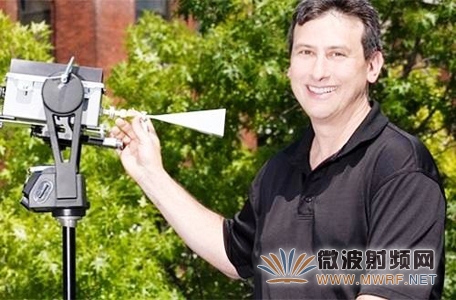зҫҺеӯҰиҖ…е‘јеҗҒж”ҝеәңејҖж”ҫжҜ«зұіжіўйў‘ж®ө иө¶дёҠ5GејҖеҸ‘и„ҡжӯҘ
зҫҺеӣҪзәҪзәҰеӨ§еӯҰзҗҶе·ҘеӯҰйҷўпјҲNYU Polytechnicпјүзҡ„з ”з©¶дәәе‘ҳTheodore Rappaportе‘јеҗҒпјҢдё»з®Ўжңәе…іеә”иҜҘејҖж”ҫжҜ«зұіжіўпјҲmillimeter waveпјүйў‘ж®өзҡ„жҺҲжқғпјҢд»ҘиҝҺжҺҘж— зәҝйҖҡдҝЎйўҶеҹҹзҡ„жҠҖжңҜеӨҚе…ҙгҖӮ
Rappaportйў„и§ҒпјҢ28~90GHzйў‘ж®өзҪ‘з»ңеҸҜжӣҝжңӘжқҘзҡ„зҡ„移еҠЁи®ҫеӨҮжҸҗдҫӣGbpsзӯүзә§зҡ„иө„ж–ҷдј иҫ“пјӣд»–зҡ„жҠҖжңҜз ”з©¶дёӯеҝғе·Із»ҸеңЁиҝӣиЎҢдёҖдәӣжҠҖжңҜжҰӮеҝөзҡ„жөӢиҜ•пјҢдҪҶиҝҳйңҖиҰҒжӣҙеӨ§и§„жЁЎзҡ„еҠӘеҠӣгҖӮ

RappaportеңЁжҺҘеҸ—EETimesзҫҺеӣҪзүҲзј–иҫ‘дё“и®ҝж—¶иЎЁзӨәпјҢ“з”өдҝЎиҗҘиҝҗе•ҶйңҖиҰҒжңүдёӘжөӢиҜ•еңәпјҢжқҘејҖеҸ‘еҗ„з§ҚиғҪиҝҗз”ЁеңЁ28GHzгҖҒ38GHzдёҺ79~90GHzйў‘ж®өзҡ„дә§е“ҒеҺҹеһӢпјӣеңЁиҜҘйўҶеҹҹе·Із»ҸжңүеҫҲеӨҡзӣёе…із ”еҸ‘жҙ»еҠЁпјҢжҲ‘еҸӘжӢ…еҝғзҫҺеӣҪдјҡеңЁе…¶дёӯиҗҪеҗҺгҖӮ”
д»–и®ӨдёәпјҢзҫҺеӣҪиҒ”йӮҰйҖҡдҝЎе§”е‘ҳдјҡпјҲFCCпјүеә”иҜҘй’ҲеҜ№з ”究用йҖ”д»ҘеҸҠдёҖдәӣ移еҠЁеә”з”ЁзЁӢејҸзҡ„иҪ»еәҰе•ҶдёҡеҢ–ејҖж”ҫдёҠиҝ°йў‘ж®өпјҢ“йҹ©еӣҪдёҺдёӯеӣҪйғҪе·Із»ҸзңӢеҲ°зӣёе…іе•ҶжңәпјҢиҖҢдё”жҳҫ然еңЁејҖж”ҫжҜ«зұіжіўйў‘ж®өз»ҷиңӮзӘқ移еҠЁйҖҡдҝЎеә”з”Ёж–№йқўжңүиҫғејҖж”ҫзҡ„жҖҒеәҰгҖӮ”802.11adж ҮеҮҶ60GHz WLANжҠҖжңҜжҳҜдёҖдёӘејҖз«ҜпјҢиҖҢд»ҚеңЁејҖеҸ‘йҳ¶ж®өзҡ„жңӘжқҘ5G移еҠЁйҖҡдҝЎпјҢе°Ҷдјҡи®©иҜҘйў‘ж®өз№ҒиҚЈеҸ‘еұ•гҖӮ
RappaportиЎЁзӨәпјҢ5G е°ҶйҮҮз”ЁжҷәиғҪеӨ©зәҝжҠҖжңҜ--е°Ҷж•°зҷҫдёӘеғҸжІҷзІ’иҲ¬еҫ®е°ҸгҖҒд»Ҙй«ҳд»Ӣз”өжқҗж–ҷеҲ¶дҪңзҡ„еӨ©зәҝе…ғ件дёҖиө·е®ҡзӣёпјҲphasedпјүпјҢ并жҙ’иҝӣжҷәиғҪжүӢжңәдёӯпјҢ“зӣёжҺ§йҳөе·Із»Ҹиў«иҝҗз”ЁеңЁи®ёеӨҡй«ҳжҲҗжң¬еҶӣдәӢзі»з»ҹдёӯпјҢиҰҒе°ҶиҜҘжҠҖжңҜеёҰеҲ°ж¶Ҳиҙ№жҖ§з”өеӯҗдә§е“ҒдёҠпјҢжҲ‘们иҝҳйқўдёҙдёҖдәӣжҠҖжңҜжҖ§й—®йўҳгҖӮ”
еңЁеҸҰдёҖж–№йқўпјҢ5GжҠҖжңҜйңҖиҰҒе…Ёж–°зҡ„ж— зәҝи·Ҝз”ұеҷЁдёҺдёӯ继еҷЁпјҲrepeaterпјүпјҢиҝҷд№ҹе°ҶдёәзҪ‘з»ңеёҰжқҘжҷәж…§еҠҹиғҪпјӣRappaportжҢҮеҮәпјҢжңӘжқҘи·қзҰ»200~400е…¬е°әиҝңзҡ„еҹәз«ҷйҖҡиҝҮеҝ«йҖҹз»“еҗҲжіўжқҹпјҢиҒ”еҗҲеңЁдёҖиө·жҸҗдҫӣе®Ҫйў‘иҝһз»“гҖӮд»–зҡ„з ”з©¶дёӯеҝғе·Із»Ҹе»әз«ӢдәҶдёҖдёӘзәҪзәҰеёӮеҶ…жҜ«зұіжіўдҝЎеҸ·дј ж’ӯзү№жҖ§зҡ„иө„ж–ҷеә“пјҢеҗёеј•дәҶеҢ…жӢ¬AT&TгҖҒIntelгҖҒSamsungзӯүдјҒдёҡиөһеҠ©гҖӮ
RappaportиЎЁзӨәпјҢ“жҲ‘们зҡ„з ”з©¶еұ•зӨәдәҶеңЁйғҪеёӮзҺҜеўғдёӯеҸҚеј№иғҪйҮҸпјҲbouncing energyпјүзҡ„ж–№еҗ‘жҖ§еӨ©зәҝпјҢиғҪеҪўжҲҗиүҜеҘҪзҡ„иңӮзӘқиҝһз»“пјҢиҖҢдё”еңЁжҹҗдәӣж–№йқўиЎЁзҺ°жҜ”еҰӮд»Ҡзҡ„иңӮзӘқзҪ‘з»ңжӣҙеҘҪгҖӮ”е…¶з ”з©¶дёӯеҝғжҺҘдёӢжқҘе°ҶејҖеҸ‘з»ҹи®ЎжЁЎеһӢд»ҘеҸҠйў‘йҒ“д»ҝзңҹеҷЁпјҢеҒҡдёә5Gзі»з»ҹдёҺж ҮеҮҶзҡ„жөӢиҜ•е№іеҸ°пјӣйӮЈдәӣе·Ҙе…·е°ҶеҚҸеҠ©зҪ‘з»ңжңҚеҠЎдёҡиҖ…иҝӣиЎҢжҲҗжң¬дј°з®—пјҢд»ҘеҸҠ规еҲ’жҜ«зұіжіўеҹҺеёӮйҖҡдҝЎзҪ‘з»ңгҖӮ
зј–иҜ‘пјҡJudith Cheng
пјҲеҸӮиҖғеҺҹж–Үпјҡ5G Spectrum Needed, Says ExpertпјҢby Rick Merrittпјү
еҺҹж–ҮеҸӮиҖғпјҡ
5G Spectrum Needed, Says Expert
US regulators need to open up licensing of millimeter wave bands to make way for a coming renaissance in wireless, according to a leading researcher.
Theodore Rappaport foresees networks using 28 to 90 GHz bands to deliver several Gbits/second to tomorrow's mobile devices. The wireless research center he runs at NYU Polytechnic is testing out such ideas, but a broader effort is needed, he said.
"We need a playground for carriers to develop the prototypes to show what can be done at 28, 38 and 70-90 GHz bands," Rappaport said in an interview with EE Times. "There's a big movement here, but I'm just afraid the US is behind in it," he said.
The Federal Communications Commission needs to license the bands for experimental and light commercial use on mobile apps, he said. "Korea and China see this opportunity and appear to be more spectrum friendly in the use of millimeter waves for cellular mobility," he added.
The 802.11ad standard for 60 GHz wireless LANs planted seeds here. But tomorrow's 5G cellular networks, now in development, could show a flowering of the spectrum, Rappaport believes.
5G "will be the first technology to use smart antennas -- hundreds of tiny antenna elements the size of a human freckle made in high-dielectric materials, phased together and sprinkled into smartphones," he said. "Phased arrays have been used in high-cost military systems, but we face a lot of technical issues bringing them to consumer products."
At the other end of the network, 5G will require new kinds of wireless routers and repeaters. This will provide intelligence for networks in which base stations collaborate to provide broadband links by quickly combining beams over distances of 200 to 400 meters, he said.
Rappaport's center has already created a database of the propagation characteristics of millimeter wave signals in urban New York. The work has attracted interest from corporate sponsors such as AT&T, Intel, Qualcomm, and Samsung.
"Our work showed directional antennas bouncing energy in an urban environment makes a good cellular link -- better than today's cellphones" in some respects, he said, pointing to a widely cited paper.
Going forward the center aims to develop statistical models and channel emulators to benchmark 5G systems and standards. The tools could help service providers develop cost estimates and plans for city-wide networks that ride millimeter waves.
Rappaport's NYU research center created a database of measured millimeter-wave propagation effects in New York's urban canyons.
—Rick Merritt, Silicon Valley Bureau Chief, EE Times

 зІӨе…¬зҪ‘е®үеӨҮ 44030902003195еҸ·
зІӨе…¬зҪ‘е®үеӨҮ 44030902003195еҸ·